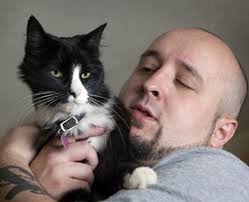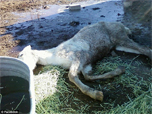From the Mafia To Mutts
James Guiliani, The Diamond Collar
 James Guiliani was the head mob enforcer in Brooklyn for over 20 years. He said he used to get a high inflicting violence on behalf of John Gotti. Now, he gets high saving animals after a dog changed his evil ways. James is our guest and he explains how he got out of the mafia and into pet rescue. Oh, he also has a brand new show on the Oprah Network.
James Guiliani was the head mob enforcer in Brooklyn for over 20 years. He said he used to get a high inflicting violence on behalf of John Gotti. Now, he gets high saving animals after a dog changed his evil ways. James is our guest and he explains how he got out of the mafia and into pet rescue. Oh, he also has a brand new show on the Oprah Network.
James Guiliani is the co-owner of Dyker Heights pet store and grooming salon. James did three years in prison as a mob enforcer, but TV's newest reality show star is now all about saving cute and furry animals. Catch James on The Diamond Collar on the Oprah Winfrey Network (OWN) Fridays at 10pm. EST and PST.
In a former life, James Guiliani, aka "Head," was a street enforcer for the mob. He ran the streets of Brooklyn for twenty-odd years working for John Gotti and his crew.
But all of this changed when he met the love of his life, Lena Pirelli, an avid animal lover and when he found an abused and abandoned dog named Bruno. James didn't know at first the Lena was the woman for him. He said she was a different type of woman; one he had never met before. Other women wanted to go out and party, but Lena was very unselfish and didn't want anything from him. Lena wasn't there to please him, but to straighten him out. In fact, the second week into their relationship, she punched him and broke his jaw. He was hooked from that day on and says he wouldn't be alive today if it weren't for her.
James basically went from a bad person to meeting the right woman, meeting the right dog and getting on track. Together, they opened up their own rescue, pet store and grooming salon. James said he put down the alcohol and drugs and basically put everything behind him and started a new life eight years ago.
When asked how he got out of the mafia, he said they let him walk away. But, if they hadn't let him walk, he would have done it anyway. He didn't want to do that any more, nor did he want violence in his life anymore.
 It all started when James and his girlfriend at the time, Lena, found a dying dog on the street. James fixed him up and brought him to the vet. James did everything possible he could do for this dog. James never had a dog before and didn't really want this dog. But Lena had different ideas and pushed the dog on James. Before this, James never did anything unselfish in his life until he met this dog, which showed him how to give back. They named the dog Bruno, but unfortunately he was dying from lymphoma. There was nothing more they could do, and he passed away on James, changing his life at the same time.
It all started when James and his girlfriend at the time, Lena, found a dying dog on the street. James fixed him up and brought him to the vet. James did everything possible he could do for this dog. James never had a dog before and didn't really want this dog. But Lena had different ideas and pushed the dog on James. Before this, James never did anything unselfish in his life until he met this dog, which showed him how to give back. They named the dog Bruno, but unfortunately he was dying from lymphoma. There was nothing more they could do, and he passed away on James, changing his life at the same time.
From that day on, James never picked up a drug or drink, nor ever committed any violent crimes. From that day on, he jumped in with two feet and started his journey in the life of rescue. It's now been eight years, which have been the best years of his life. James says it's almost like being reborn.
James currently has 30 animals at home and another 32 in his rescue. He also started an organization called Keno's Animal Rescue in Brooklyn.
James and Lena didn't cut their own sizzle reel or audition for reality show fame. Instead, one of their customers recommended the Diamond Collar for a segment on an Animal Planet show. The segment was shot but never aired
James says he received offers from other networks, but decided to go with OWN out of a lifetime admiration for its namesake, Oprah.
James said that when Oprah's name is involved, "How could you not go with her. She's an animal lover." James also said, "I've always loved Oprah. I've always loved everything about Oprah. I watched her when I was a kid." James wanted a clean channel for people to learn. He feels Oprah's platform is the best for him to do that. When he was approached by OWN, he said it only took minutes for him to decide to go with them.
 The show, The Diamond Collar, is about James life with his wife Lena. It is about how she transformed him into what he is now. On the show, James goes out everyday and rescues what animals he can. He doesn't overwhelm himself, but does the best by the animal.
The show, The Diamond Collar, is about James life with his wife Lena. It is about how she transformed him into what he is now. On the show, James goes out everyday and rescues what animals he can. He doesn't overwhelm himself, but does the best by the animal.
James says anyone can do what he does. It doesn't take a TV show. It doesn't take celebrity status. It doesn't take money. It just takes going to get something, love it and save it. When asked how many animals James has saved, he replies, "I don't count."
Some of James old friends are shocked at his transformation. In fact, someone saw him on TV and almost fell off the couch when they heard his voice. All of this feels good to James and now he knows what he wants to do. He wants to change people that are like how he was and make them into what he is now.
James also tells us about a woman that came into his shop after the show aired to bring him a stray kitten and to thank him. It turns out her son had watched an episode and decided to go out and help animals. He had found a kitten under a car in the snow and managed to catch it. James wanted to thank the woman, but she was so thankful, because she told James that before his show, her son never would have done this for an animal. James was able to change a 12-year-old's mind, so instead of turning a blind eye to an animal in need, he stopped and did the responsible thing.
James said this is a victory!
Visit Website
Cat Film Festival
William Braden, Henri le Chat Noir
 The Internet Cat Video Festival is selling out and attracting huge audiences nationwide. It's not a bunch of single cat-women that are attending these feline festivities either. William Braden, winner of the Golden Kitty Award for his viral videos, is hosting the event. He joins us and explains this strange phenomenon and our unquenchable desire for cat videos.
The Internet Cat Video Festival is selling out and attracting huge audiences nationwide. It's not a bunch of single cat-women that are attending these feline festivities either. William Braden, winner of the Golden Kitty Award for his viral videos, is hosting the event. He joins us and explains this strange phenomenon and our unquenchable desire for cat videos.
The tour started in Seattle and has hit cities such as Boise, Reno and Los Angeles. Catvidfest is a live event featuring 85 cat "meow-vies" lovingly selected by purr-fectionist fans. Besides a 75-minute compilation of video clips, the fest features a cat-themed costume competition, cat product vendors and representatives from local animal shelters and Humane Society chapters
The first Internet Cat Video Film Festival began two years ago at the Walker Art Center in Minneapolis, which drew a Woodstock-esque crowd of more than 10,000 fans.
One of those films was Henri, le Chat Noir (French for "The Black Cat"), which is a web series of short films on the existential musings of the tuxedo cat Henri. William Braden creates the series.
 The first short film of Henri was a film project by William Braden who was studying at the Seattle Film Institute. In 2006 he was supposed to make a profile film of someone. William procrastinated and didn't have enough time to finish it. At the same time, he had been watching a lot of black and white French films. He though that maybe if he did a profile of a cat and made it into a parody, no one would notice that he didn't follow the assignment.
The first short film of Henri was a film project by William Braden who was studying at the Seattle Film Institute. In 2006 he was supposed to make a profile film of someone. William procrastinated and didn't have enough time to finish it. At the same time, he had been watching a lot of black and white French films. He though that maybe if he did a profile of a cat and made it into a parody, no one would notice that he didn't follow the assignment.
Braden would write the scripts and his mother, who is fluent in French, would help with pronunciations and proper usage. Henri was shot, edited, narrated, and written in eleven days. A total of 11 short films of Henri have been made by William, and film critic Roger Ebert called Henri 2, Paw De Deux "The best internet cat video ever made."
But why cat videos? William explains that first of all, everyone pretty much likes cats. Cats are immensely popular, but they don't get to be out in the world as much as dogs. There aren't any "cat parks" and you don't see anyone walking their cats around town with leashes. So the Internet sort of became the virtual way for people to share their experience of having a cat. William also says the he thinks these videos have always been really popular, its just that in the last couple of years it became a little more "acceptable" to actively like them. People no longer had to be embarrassed to admit that they watched them and be called a "crazy cat lady."
In the last couple of years, the lid has come off of it and it is now an okay, fun thing to enjoy without being embarrassed. So find out where the next Catvidfest will be and attend!
Visit Website
How to NOT Train a Dog - Dr. Debbie
 The other day I was walking my dog in a community area and encountered a lady with two Shih Tzus. As we approached, her dogs rallied with barking and tugging on their leashes. I asked if her dogs were friendly, so as to decide if we could approach. The lady scowled, embraced her still barking dogs and grumbled, "Do they look like they're friendly?"
The other day I was walking my dog in a community area and encountered a lady with two Shih Tzus. As we approached, her dogs rallied with barking and tugging on their leashes. I asked if her dogs were friendly, so as to decide if we could approach. The lady scowled, embraced her still barking dogs and grumbled, "Do they look like they're friendly?"
Realizing this dog owner was more unsociable than her dogs, I decided to vamoose, but not before I envisioned this blog topic - how pet owners mold unsocial dog behavior.
Unwanted doggie behavior such as lunging and barking on the leash become established when the dog owner hasn't made it clear what the appropriate behavior is, fails to correct and redirect to a more suitable behavior, or simply reinforces the undesirable behavior through actions or words. Face it - there aren't bad dogs, just poorly trained ones.
Avoid making these top 5 training mistakes:
1. Secluding Your Dog in the Backyard
Keeping your dog in lock down almost guarantees problem behaviors will develop such as biting, inter-dog aggression and phobias to anything from noises to car travel. Isolated dogs lack the experience and confidence when faced with novel situations while socialized dogs adapt easily.
I see it all the time - the dog owner prides herself in keeping her dog safe. "I didn't want Fido to catch any diseases as a pup, so I didn't let him out of our backyard till he was a year old." The overwhelming fear of infectious diseases like parvovirus causes some well-meaning owners to confine their new dog or puppy to the limits of house and yard. Even more extreme is never allowing a puppy to step foot outside until after their last puppy vaccinations! Puppies are most adaptable to new experiences between 6 and 16 weeks - this is the time to expose them to unfamiliar places, people and animals.
That doesn't mean you should take your eight week old puppy to dog parks, but rather to use good sense selecting low dog traffic areas and visiting with family and friends outside of the home that have properly vaccinated pets.
2. Skipping Obedience Training
Going to school is a must for any new dog to a home, whether a puppy or adult. No two dogs are the same, and each learns differently. Formal obedience training is a useful tool to gently reaffirm who's in charge and sets the rules in the house. Statistics show that dogs that go through formal obedience training are less apt to develop behavior problems and be relinquished to shelters.
 3. Reinforcing Fear at the Veterinary Office
3. Reinforcing Fear at the Veterinary Office
In the exam room I cringe when I see a dog owner comforting a nervous, fearful or aggressive pet. That "good boy" and pat on the head reinforces your dog's behavior, making it more likely that on the next hospital visits he'll behave the same, or worse. Some problem behaviors escalate making it difficult for the veterinary staff to examine or treat the animal. This may mean additional costs for sedation or anesthesia for routine medical needs.
It's natural for a pet owner to want to reassure a pet when he is frightened and it can be difficult to hold back the urge to soothe him. However, the best strategy is to ignore those fearful behaviors in the vet office. Don't be tempted to kiss, snuggle or hold Fido on your lap when he is misbehaving. Rather, place the dog on the floor, refocus your dog's attention to you, and cue him to "sit" or "lie down."
4. Not Using Food as a Reward
Food shouldn't just be for the taking. Don't leave food out for your dog to graze whenever he wants and don't give treats just for the sake of giving a treat. Present food and treats as a reward for good behavior such as sitting quietly, going to a pillow, or performing a trick or obedience work. This places you at the top of the household hierarchy. You become the provider of great edibles in the house, and your dog will be motivated to listen to your requests in other situations.
We all love to spoil our dogs and give treats at times. But be sure to give treats for a reason, or you will have a spoiled doggie brat on your hands.
5. Not Exercising Your Pet Enough
Inadequate exercise can result in obesity and boredom, and may lead to problem behaviors like separation anxiety, destructive chewing and excessive barking. Dogs should get 30 to 60 minutes of sustained physical activity each day for optimum mental and physical benefit. And no - letting Buffy run around the backyard during the day is not adequate exercise.
Not all breeds are cut out for all exercise - a Labrador may enjoy retrieving games or swimming, a Jack Russell terrier may thrive with jogging or Frisbee, while a Basset hound will be satisfied with a leash walk.
Your dog can't be a well-adjusted, socialized canine citizen without you, as the pet owner, taking an active role in training. Put the time in, and you'll be thanked many times over with an outgoing, friendly canine pal that can accompany you on life's adventures.
Featured veterinarian known as "Dr. Debbie" on national pet radio program, Animal Radio. Ebook author of "Yorkshire Terriers: How to Be Your Dog's Best Friend"; "Pugs: How to Be Your Dog's Best Friend"; "Mini Schnauzers: How to Be Your Dog's Best Friend"; and "Shih Tzu: How to Be Your Dog's Best Friend." Dr. Debbie's books.
Visit Website
 The Dogfather's Grooming Tip with Joey Villani
The Dogfather's Grooming Tip with Joey Villani
How Damaging Is Winter Salt To Your Dog?
How does the rock salt that is applied to sidewalks and the streets during the winter affect your pet's coat? Think about how it affects everything else! It can do a great amount of damage to even cars, let alone your pet.
As the salt gets on your pet, it dries out their hair, which leads to breakage, hair loss and irritation. This doesn't even include the damage it can do to your dog's feet.
The best things you can do are brush and comb your pet out very thoroughly after they've been outside. When you think you have removed all of the salt, feel you dog's coat. If there is any salt left, you will be able to feel it. While bathing the coat is the most effective, it's not practical to do this every time you take your dog out.
Once you have it brushed out and all of the salt is removed, a great product to apply is Moroccan Oil, a conditioning treatment for human hair. You can find this at most supermarkets. For your dog, you just need a small amount, about the size of a dime. Rub it on your pet and work it into their coat and then re-brush and re-comb it in. The oil will give it a protective barrier against further exposure to salt. The salt will no longer be able to stick to your pet's coat and penetrate it. This will keep your dog from suffering rom major hair breakage.
Animal Radio® News with Stacey Cohen
 Most Interesting Man In The World Raises Money To Fight Dog Cancer
Most Interesting Man In The World Raises Money To Fight Dog Cancer
The most interesting man in the world is helping a Vermont-based company raise money to fight cancer in dogs. Jonathan Goldsmith is a Manchester resident made famous by his role in the Dos Equis beer commercials. But he's also a dog lover hoping to raise funds for the Denver-based Morris Animal Foundation, which promotes veterinary research for companion animals, horses and wildlife. "It's very simple. It takes money, and I can help them raise money," said Goldsmith, who has two Anatolian shepherds and lost a third dog to canine cancer. "The nicest thing about so-called celebrity status is to be able to call attention to the things that you believe in."
Pet First Aid App
A new app from the American Red Cross helps dog and cat owners care for their pets in emergency situations. The Red Cross Pet First Aid app is available for iPhones and Androids, and costs $0.99 to download. It features step-by-step instructions, videos and images on how to treat more than 25 common first aid situations for pets, including bleeding, burns and cardiac and respiratory problems. Other features of the app include:
• Create a pet profile: tag identification number, photos, list of medications and instructions.
• Use the list of early warning signs to learn when to call their veterinarian.
• Use "click-to-call" to contact their veterinarian.
• Find emergency pet care facilities or alternate veterinarians with the "animal hospital locator."
• Locate pet-friendly hotels.
The Pet First Aid App and other Red Cross apps may be found in the Apple App Store and the Google Play Store for Android by searching for American Red Cross or by going to redcross.org/mobileapps.
Sicker Pets, But Less Vet Visits
There's an American health crisis that doesn't have anything to do with federal health care websites, rising deductibles or doctor shortages. Pets are getting sicker and many owners don't have a clue. One reason is that they're not going to the vet. Dog vet visits have slipped 21 percent since 2001 and cat visits have dropped 30 percent, according to the American Veterinary Medical Association. Meanwhile, emergency visits have increased, indicating people are waiting until their pets are really sick to do anything about it. The crisis in pet health has spurred a new $5.5 million public awareness campaign urging annual checkups. The campaign is sponsored by a consortium called Partners for Healthy Pets, made up of the AVMA, the AAHA and more than 90 other veterinary organizations. The big thing we all tend to forget is a pet's lifespan is 10 to 15 years. Skipping a yearly physical is like a person not going to a doctor for five or seven years. The sooner you catch any disease, the easier it is to treat it successfully.
 Animal Cruelty Charges in Horse Neglect
Animal Cruelty Charges in Horse Neglect
The death of a young horse rescued in Enoch, Utah is rousing animal-cruelty activists. Kendra Munden with Madaresgold Horse Rescue says there's no excuse for Elsa's death. Rescuers found the young malnourished horse several weeks ago. Her head was frozen to the ground. Elsa's mom is still being cared for at a Cedar City sanctuary. An Enoch City man is facing animal-cruelty charges in connection with the incident.
Leave Your Pet Out In The Cold - Be Charged With A Felony
Anyone who leaves a dog outside in the cold should be charged with a felony, says State Senator Greg Ball. Ball is calling on tougher new legislation to protect dogs and cats from being left outside in the cold all day. The legislation comes in the wake of an incident that occurred at an upstate puppy mill. The new legislation, which is being drafted, will make it a felony for intentionally failing to provide adequate shelter for a dog. The owner of the puppy farm upstate was charged with a violation of the state's Agriculture and Markets Law, which caries a maximum fine of $100. The legislation will make state law on this fall into line with the punishment for Buster's Law punishable with up to two years in prison and a $5,000 fine. Recently, Gov. Cuomo signed legislation co-sponsored by Ball to enable local governments to regulate pet dealers and puppy mills.
Should Pet Cemeteries Bury Horses?
A pet cemetery owner in eastern Iowa is battling state regulators over the proper procedure for burying horses. The Iowa Department of Natural Resources has fined Steve Johnson, of Tipton, $10,000 for not sending dozens of horses to a landfill. The state considers the animals to be "solid waste" that should be discarded in that manner. Johnson is appealing the fine to the Iowa Environmental Protection Commission. Johnson's attorney says his client gives the horses a dignified burial. A DNR attorney says the agency is concerned about the quality of the state's groundwater. Experts in the industry of pet burials say states like Iowa may not be keeping pace with how owners want to treat their deceased animals.
 Cockroach Pulled Out Of Man's Ear
Cockroach Pulled Out Of Man's Ear
An Australian man is gaining worldwide notoriety for the critter that was recently pulled out of his ear. According to the Australian Broadcast Corporation, doctors pulled a cockroach out of Hendrick Helmer's ear that was nearly an inch long. The roach was first killed with olive oil and then taken out with forceps. Apparently, the insect had crawled into Helmer's ear at night and he awoke the next morning in incredible pain. News of the incident has been circulated on websites around the world. Hendrik says he "wasn't expecting" the news to travel so fast, but understands because many people are "freaked out" by the idea of having an insect inside their ear.
 Listen to the entire Podcast of this show (#1053)
Listen to the entire Podcast of this show (#1053)





